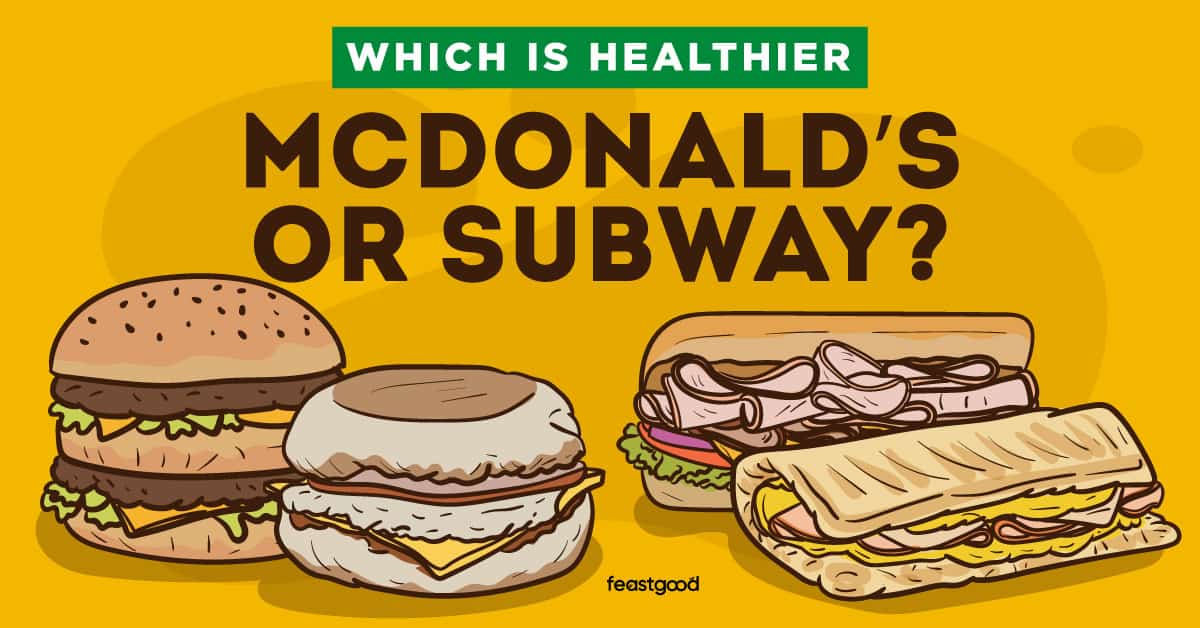When you need a convenient meal or snack when you are on the go, a fast food restaurant like McDonald’s or Subway is an obvious choice. But, how can you know which restaurant is better for your health?
Is McDonald’s or Subway healthier? Subway is healthier than Mcdonald’s because of the large number of veggies that can be added to any sandwich. As well, on average, Subway has lower calories and fat per meal, and any sub can be converted into a salad. However, McDonald’s is better for vegans & vegetarians because of its high protein meat alternatives.
Weighing healthy options depends on many factors, including: calories, macronutrients (carbs, fat and protein), sodium, and ingredient quality. As well, whether you can customize the meal options to meet your specific nutrition goal.
In this article, I’ll show you how these restaurants stack up against each other based on these criteria.
McDonald’s vs. Subway: Overview
McDonald’s
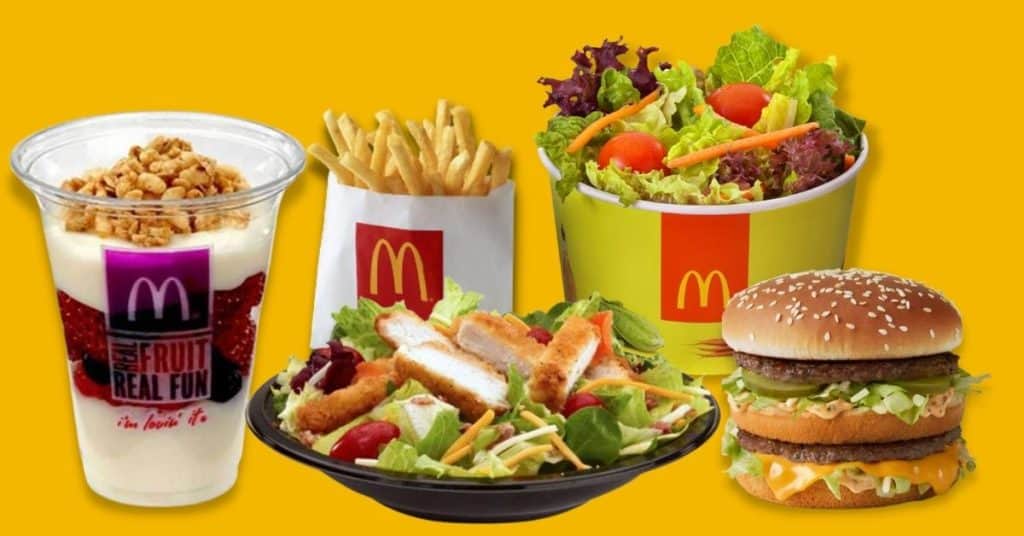
McDonald’s is first known for its beef burgers and fries, but the restaurant also has chicken, fish, and plant-based burgers.
They also have wraps and breakfast items including bagels, muffins, donuts, and specialty coffees, in addition to several dessert items (ice cream, shakes, and cookies).
McDonald’s did temporarily remove salads from its menu in 2020 due to the coronavirus pandemic’s disruption on the supply chain for produce, but a few limited salad offerings are slowly starting to reappear on their menu now.
In order to calculate McDonald’s average nutritional information, I focused on its 22 main burger/sandwich options (beef, chicken and fish). I also looked at other products such as salads and wraps in order to compare with Subway’s salads and wraps.
The average nutritional information for the 22 main burger/sandwich options was 498 calories with 44g of carbs (2.9g fiber), 23.5g fat (7.5g saturated), and 27.5g protein, and 1057mg of sodium.
Key Takeaway: This is 43% more calories than a 6” sub from Subway, and most of those extra calories come from fat because the average McDonald’s burger has 11g more fat than the average Subway sub. However, the protein content is 5g more than a Subway sub.
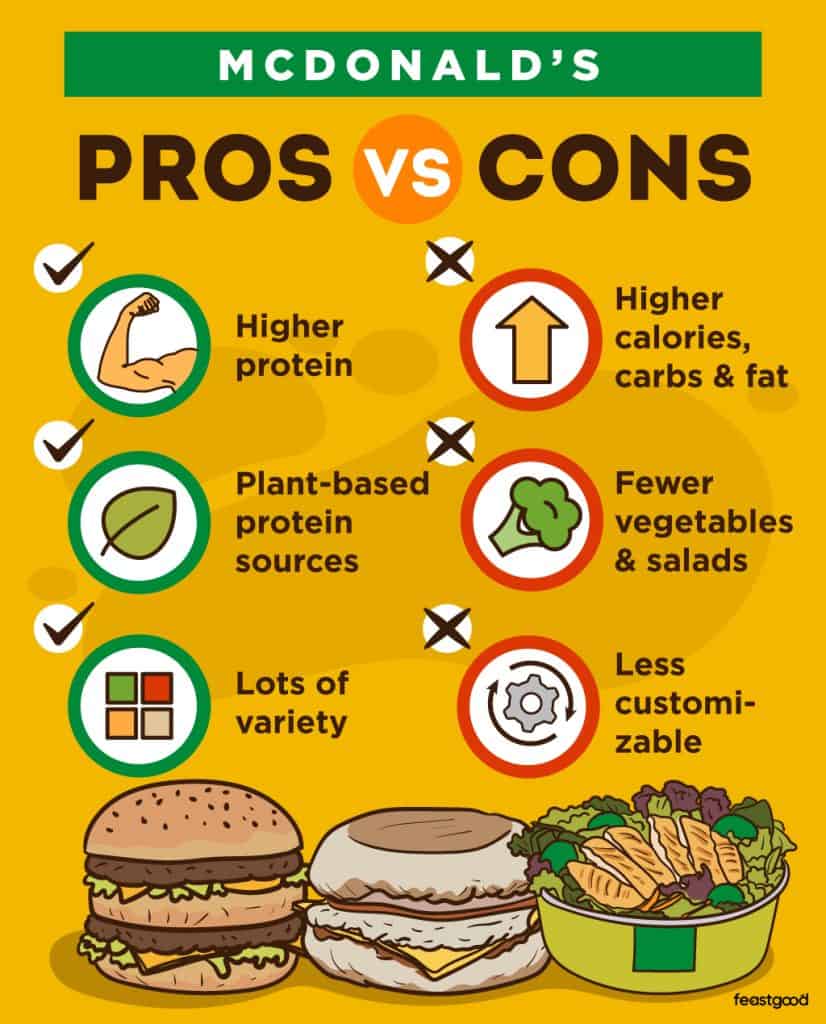
Pros
- Higher protein
- Plant-based protein sources
- Lots of variety
Cons
- Higher calories, carbs and fat
- Fewer vegetables and salads
- Less customizable
Subway
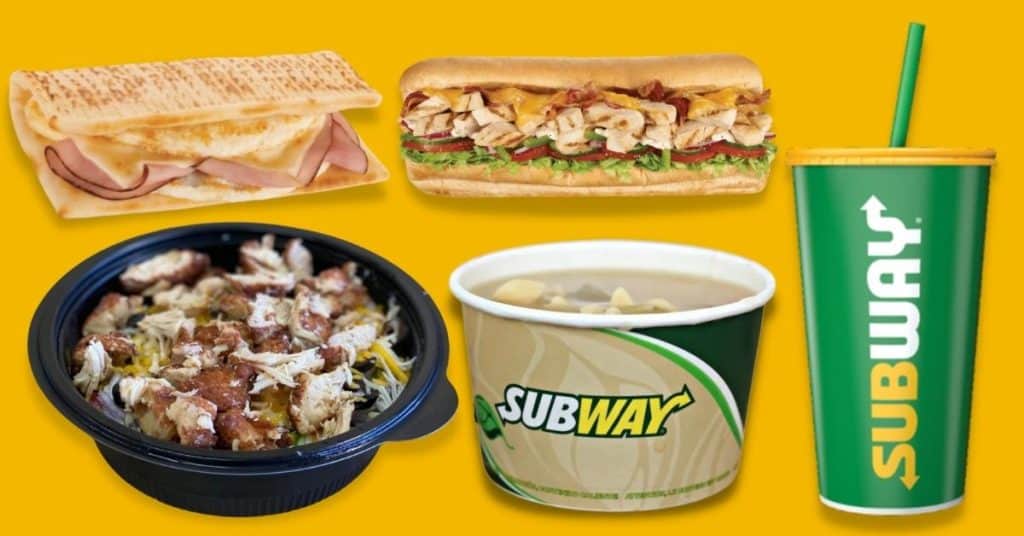
Subway carries sandwiches, salads, and soups and has cookies and chips available to complete a meal.
The chain is very well known for its “Jared ads” promoting the ability to eat well and lose weight by choosing Subway.
All of Subway’s sandwiches can be made into a salad instead; turning a footlong (12”) sub into a salad is called a “Protein Bowl” because it uses a double portion of protein (twice the serving of protein in a standard 6” sandwich).
A salad or protein bowl is also much lower in carbs than a sub or wrap.
Consumers also have the option to turn footlong subs into wraps, which contain the double protein portion. This is another great option for people who struggle to eat enough protein, but it is still high in carbohydrates.
Subway’s average nutritional information for this review is based on its 17 standard 6” sandwiches.
The average nutritional information for the 17 standard 6” sandwiches was 348 calories with 40g of carbs (2.7g fiber), 12.5g fat (4.4g saturated), and 22.2g protein, and 951mg of sodium.
Key Takeaway: Subway sandwiches are lower in calories (-150) than McDonald’s burgers, mainly due to their lower fat content (-11g), and slightly lower carbs (-4g). They are also lower in sodium by ~100mg, and the vegetable toppings provide more micronutrients. With that said, the protein content is lower by 5g.
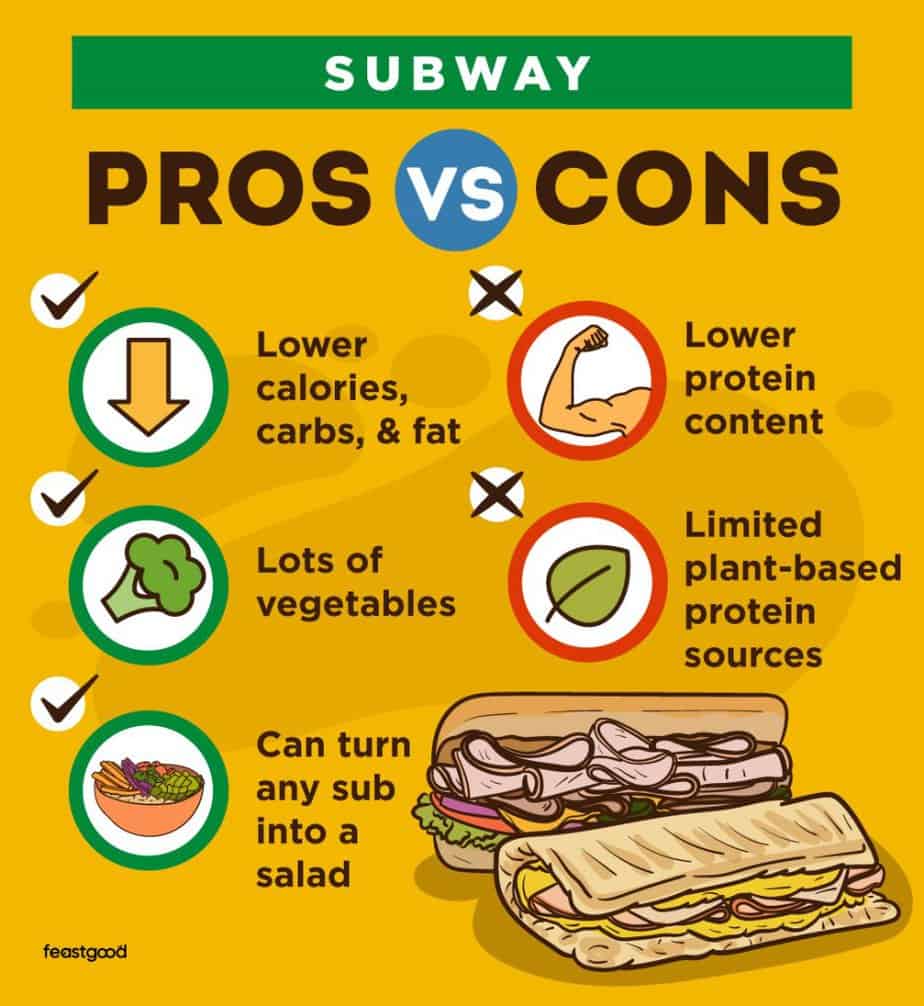
Pros
- Lower calories, carbs, and fat
- Lots of vegetables
- Can turn any sub into a salad
Cons
- Lower protein content
- Limited plant-based protein sources
Related Article: 8 Best Low Sodium Subway Meals
Comparing McDonald’s & Subway: Which is Healthier?
To determine whether McDonald’s or Subway is healthier, I compared them across several different criteria, including:
- Low-calorie Options
- Carbohydrate Content
- Fat Content
- Protein Content
- Sodium Content
- East of Customization
Check out more restaraunt comparisons on our Fast Food Fitness page where we explore how to stay on track with your goals while on-the-go.
Low-calorie Options
Not only are Subway’s standard sandwich offerings lower in calories than McDonald’s burgers and sandwiches, Subway also has four mini subs that are all <200 calories.
McDonald’s offers its wraps as snack-size options, but these wraps are still higher in calories than Subway’s standard sandwiches, with 379 calories on average.
When it comes to Subway’s wraps, they’re actually higher in calories than their standard sandwiches. These full-size wraps are the highest calorie main menu items, providing an average of 605 calories. This is more than the average burger at McDonald’s.
McDonald’s does have the single lowest-calorie item overall: its side salad is only 20 calories without dressing. Subway’s Veggie Delite salad is 50 calories.
It is worth noting, however, that Subway’s Veggie Delite salad is a serving size of 287g whereas McDonald’s side salad is only 87g. The Subway salad is more than three times the size, but does not have three times the calories, so it is a less calorie-dense option and would be more filling.
The Winner: Subway
- The winner for low-calorie options is Subway for main menu items. Even McDonald’s “snack” wraps have more calories than Subway’s standard sandwiches. Salads without dressing at the two restaurants have nearly the same average calorie count (~225).
Carbohydrate Content
On average, Subway’s standard sandwiches have a lower carbohydrate content (40g) than the average burger at McDonald’s (44g). The ability to turn any sub into a salad at Subway is also a great option for anyone looking to reduce their carbohydrate intake.
Subway’s standard salads have an average of 13g of carbs, compared with 19g of carbs for McDonald’s salads.
I also want to point out that many people mistakenly believe that a wrap is a healthier option. Many wraps contain more calories and carbohydrates than the bread-based buns that they are replacing.
For example, Subway’s spinach and tomato basil wraps each have 290 calories and 49g of carbs whereas the 6” artisan Italian bread has 160 calories and 34g of carbs. The wrap is only a better choice if it is used to replace 12” (footlong) bread choice.
At McDonald’s, snack-size wraps are only 5g fewer carbohydrates than the average burger.
The Winner: Subway
- The winner for lower-carbohydrate options is Subway, except for its wraps. McDonald’s snack-size wraps have approximately the same amount of carbohydrates as Subway’s standard 6” subs (1g less).
Fat Content
Subway’s 6” subs have an average fat content of 12.5g, which is about half of the average fat content of a McDonald’s burger (23.5g).
Even more important, the saturated fat content at Subway is on average 4.4g compared with 7.5g at McDonald’s.
The Double Quarter Pounder with Cheese at McDonald’s has 19g of saturated fat and its breakfast menu includes an option with 20g of saturated fat (the Big Breakfast with Hotcakes and Large Size Biscuit). McDonald’s McFrappe drinks all have 13-18g of saturated fat, and those are just beverages.
Across its standard subs, Subway’s highest saturated fat content is 11g, in the 6” Chicken & Bacon Ranch sub with rotisserie-style chicken.
The Winner: Subway
- The winner for lower fat and lower saturated fat is Subway. There are more main menu items at Subway that range from 0-10g of saturated fat, and more menu items at McDonald’s that range from 10-20g of saturated fat.
Protein Content
McDonald’s burgers provide more protein on average (27.5g) than Subway’s 6” sandwiches (22.2g).
McDonald’s and Subway salads offer virtually the same amount of protein at around 18g. However, Subway does have a “protein bowl” option, where you can turn a footlong sandwich into a salad, which offers 33g of protein on average.
Subway’s wraps do provide significantly more protein than McDonald’s wraps (37g compared with 20g), but they are also twice as big (337g vs 148g).
As far as plant-based protein options, Subway has a Veggie Patty, which has 6g of protein. In comparison, the McPlant burger has19g of protein.
The Winner: McDonald’s
- The winner for protein content is McDonald’s. McDonald’s McPlant burger also provides more protein than the Subway Veggie Patty 6” sub.
Sodium Content
McDonald’s burgers have an average of 1057mg of sodium, which is slightly more than the 951mg in Subway’s standard 6” subs.
Looking at a value of around 1000mg for a single burger or sandwich, this means 43-67% of the total recommended intake for sodium from one item.
The lowest-sodium options are McDonald’s salads, with an average of 572mg of sodium without dressing. However, a single packet of dressing nearly doubles that amount, with an average of 566mg of sodium.
Subway’s standard salads have 694mg of sodium, but the average dressing sodium content is only 133mg, and there are a few sodium-free dressing options including oil and various vinegars. Subway’s Protein Bowls average 1328mg of sodium.
The Winner: Subway
- The winner for lowest sodium content for main menu items is Subway. McDonald’s salads without dressing have the lowest sodium content, but Subway has lower-sodium dressing options for its salads.
Ease of Customization
Subway makes it easy to double the protein in any sandwich, or to turn any sandwich into a salad or a wrap. Also, customers get to pick exactly which vegetables they want in the salad or wrap, and how much of each.
McDonald’s does not provide anywhere near this level of customization. Some toppings and condiments can be added or removed from burgers (for example no cheese and no pickle), but there is a much smaller selection of vegetables and topping to choose from.
McDonald’s salads are pre-made and pre-packaged, so there is no opportunity for customization there.
It is possible to ask for a burger with no bun at McDonald’s, but there is no way to turn that burger into a salad.
The Winner: Subway
- The clear winner for customization is Subway, to more easily suit allergies, intolerances, and preferences, and the ability to meet dietary preferences, such as low- or high-carb, low-fat, etc.
Similar Meals: Head to Head Comparison
Despite the fact that Subway was the overall winner as the healthier choice, depending on certain specific menu items, you will see that McDonald’s sometimes has the better option. Let’s now compare similar meals across both these fast food chains.
McDonald’s Big Mac vs Subway All-American Club 6” Sub
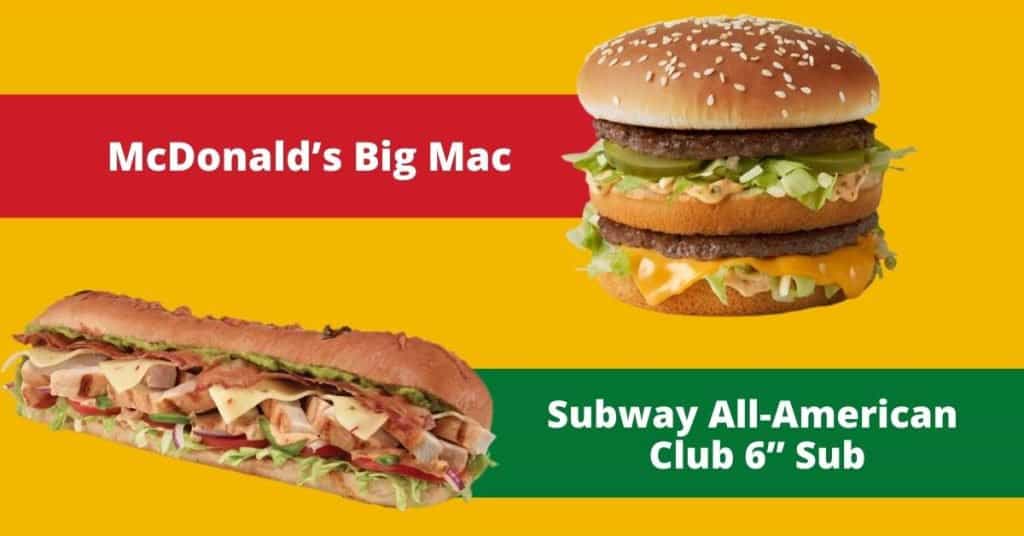
| Nutrition Info | McDonald’s Big Mac | Subway All-American Club 6” Sub (+ cheese) |
|---|---|---|
| Calories | 540 | 390 (+40) |
| Carbs | 45g | 39g (+0g) |
| Fat | 29g | 13g (+4g) |
| Protein | 25g | 25g (+2g) |
| Sodium | 1040mg | 1220mg (+210mg) |
The Subway All American Club 6” sub is lower in calories, carbs, fat and protein, even when a slice of cheese is added. McDonald’s Big Mac is lower in sodium.
The Winner: Subway
- Overall, the Subway All-American Club 6” sub is a healthier choice than a Big Mac from McDonald’s. In fact, all of Subway’s standard 6” subs are lower in calories than a Big Mac.
McDonald’s Premium Bacon Ranch Salad with Grilled Chicken vs. Subway Grilled Chicken & Bacon Ranch Salad (no dressing)
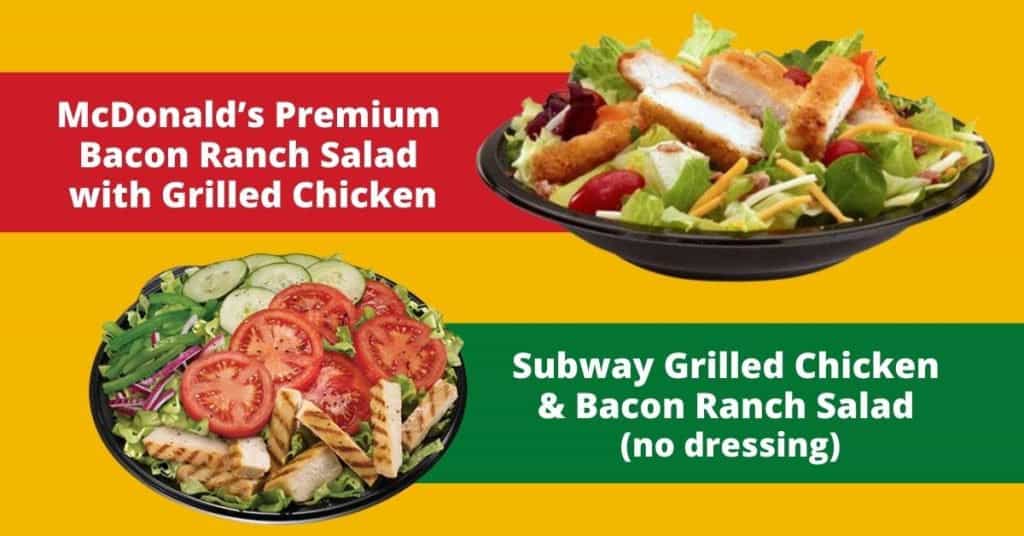
| Nutrition Info | McDonald’s Premium Bacon Ranch Salad with Grilled Chicken | Subway Grilled Chicken & Bacon Ranch 6” Sub |
|---|---|---|
| Calories | 260 | 390 |
| Carbs | 12g | 12g |
| Fat | 9g | 26g |
| Protein | 33g | 32g |
| Sodium | 1010mg | 740mg |
McDonald’s Premium Bacon Ranch Salad with Grilled Chicken is lower in calories and much lower in fat, with just over a third the fat content of the Subway Grilled Chicken & Bacon Ranch Salad.
Note, however, that the Subway salad is lower in sodium, and Subway also has sodium-free options for dressings.
The Winner: McDonald’s
- Overall, the McDonald’s Premium Bacon Ranch Salad with Grilled Chicken is a healthier option than the Subway Grilled Chicken & Bacon Ranch Salad.
McDonald’s Premium Grilled Chicken Ranch BLT Sandwich vs. Subway Grilled Chicken & Bacon Ranch 6” Sub
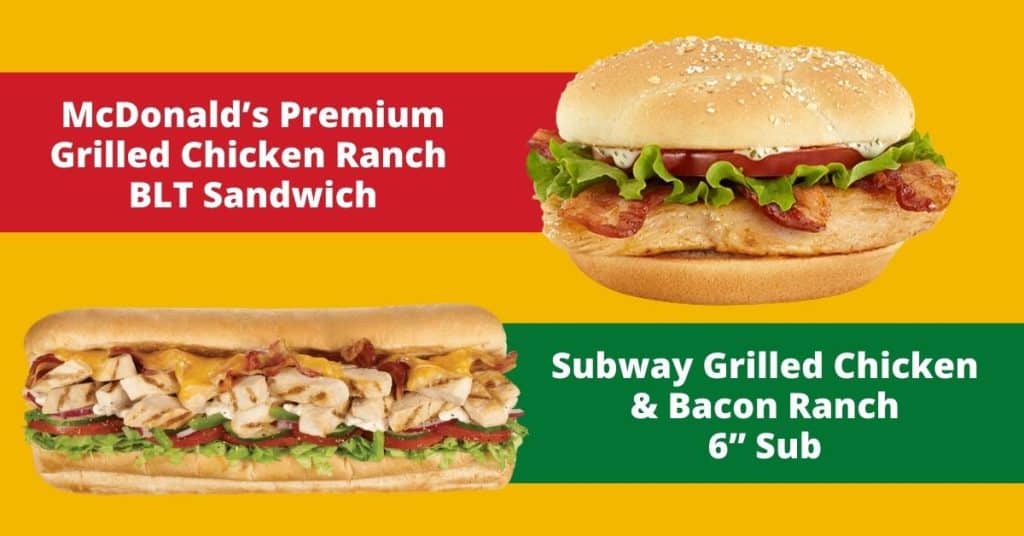
| Nutrition Info | McDonald’s Premium Grilled Chicken Ranch BLT Sandwich | Subway Grilled Chicken & Bacon Ranch 6” Sub |
|---|---|---|
| Calories | 380 | 510 |
| Carbs | 41g | 39g |
| Fat | 10g | 27g |
| Protein | 31g | 36g |
| Sodium | 1000mg | 1020mg |
The Premium Grilled Chicken Ranch BLT Sandwich from McDonald’s is lower in calories and much lower in fat, with just over a third the fat content of the Subway Grilled Chicken & Bacon Ranch 6” Sub.
The carbohydrate and sodium content are very similar, while the sub offers 5g more protein.
The Winner: McDonald’s
- Overall, the McDonald’s Premium Grilled Chicken Ranch BLT Sandwich is a healthier option than the Subway 6” Chicken & Bacon Ranch 6” sub.
McDonald’s Egg McMuffin vs. Subway 6” Black Forest Ham, Egg White & Cheese Flatbread
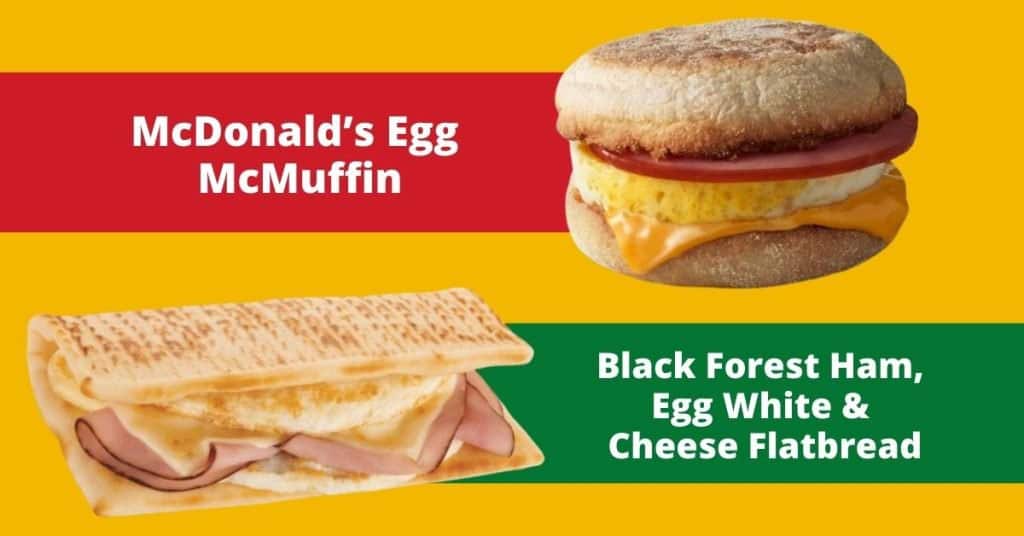
| Nutrition Info | McDonald’s Egg McMuffin (includes ham) | Subway 6” Black Forest Ham, Egg White & Cheese Flatbread |
|---|---|---|
| Calories | 300 | 390 |
| Carbs | 30g | 45g |
| Fat | 12g | 12g |
| Protein | 18g | 23g |
| Sodium | 820mg | 1110mg |
The McDonald’s Egg McMuffin is lower in calories, carbs and sodium than the Subway breakfast flatbread with egg white, black forest ham, and American cheese.
The Subway flatbread does offer 5g more protein and is a good choice for a meal with a 2:1 carb to protein ratio which could be of interest for a bodybuilder.
The Winner: McDonald’s
- Overall, the McDonald’s Egg McMuffin is a healthier option than the Subway 6” Black Forest Ham, Egg White & Cheese Flatbread.
Healthy Meal Options At McDonald’s and Subway
Below, I’ll give my top recommendations for the healthiest meals at either McDonald’s or Subway.
Healthy Meal Options from McDonald’s
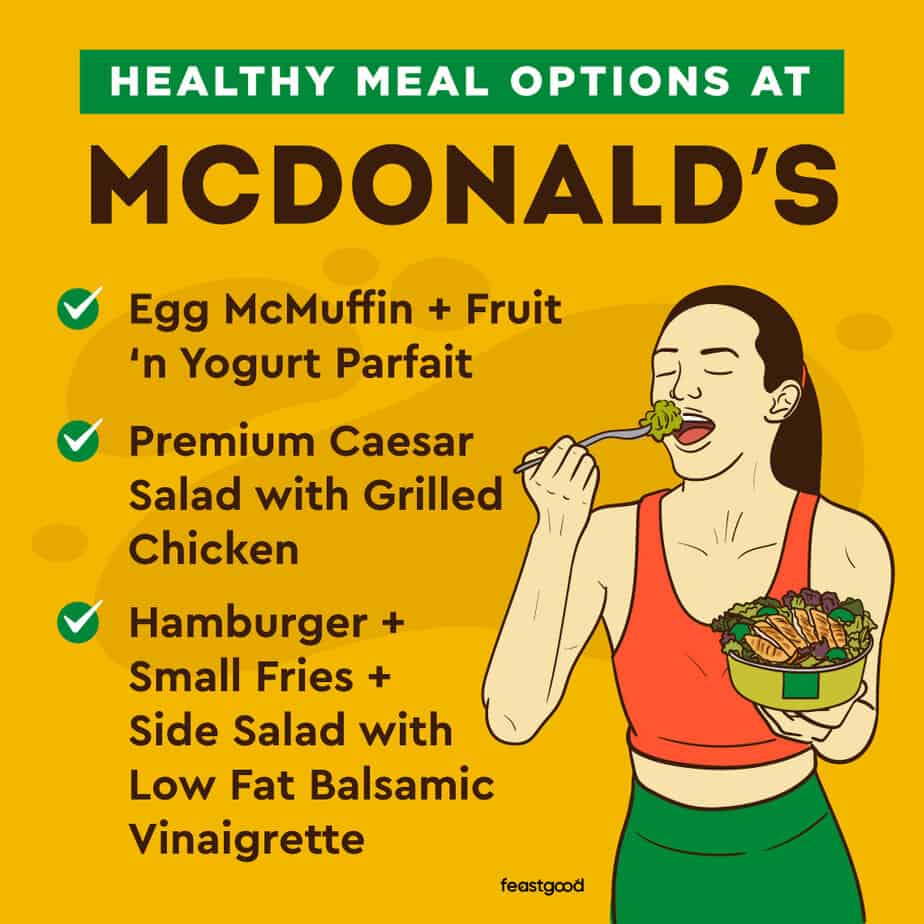
1. Egg McMuffin + Fruit ‘n Yogurt Parfait
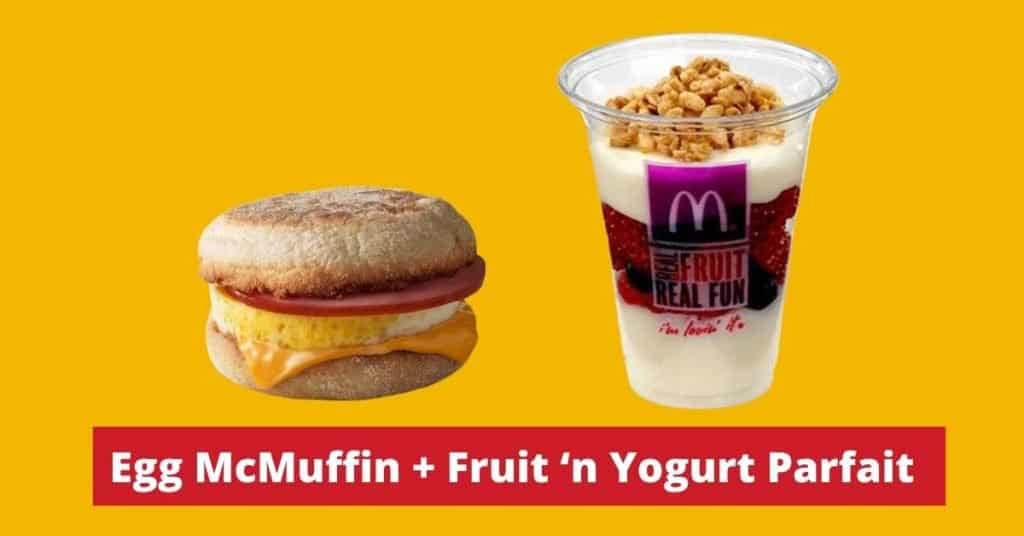
The Egg McMuffin on its own is a relatively low-calorie, balanced option with a good amount of protein.
However, this breakfast sandwich is missing some micronutrients and fiber. Adding the fruit and yogurt parfait adds fruit to provide vitamins and fiber and the yogurt provides some additional protein.
The overall meal is 460 calories, with 61g of carbs, 22g of protein, and 14g of fat. Total sodium content is 905mg.
2. Premium Caesar Salad with Grilled Chicken
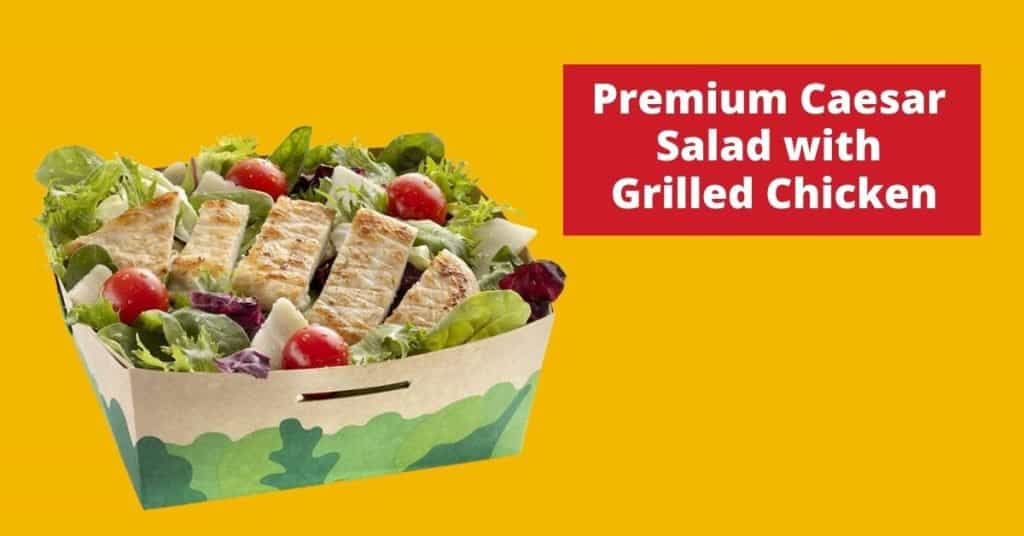
The Caesar Salad with Grilled Chicken has 220 calories, with 12g of carbs, 30g of protein, and 6g of fat. The salad on its own has 890mg of sodium.
Adding Newman’s Own Low Fat Family Recipe Italian Dressing adds 60 calories, with 8g of carbs, 1g of protein, and 2.5g of fat. The dressing does have 730mg of sodium, so you will need to skip it if you are watching your sodium intake.
This high-protein meal will keep you feeling full and the big salad provides lots of beneficial micronutrients.
3. Hamburger + Small Fries + Side Salad with Low Fat Balsamic Vinaigrette
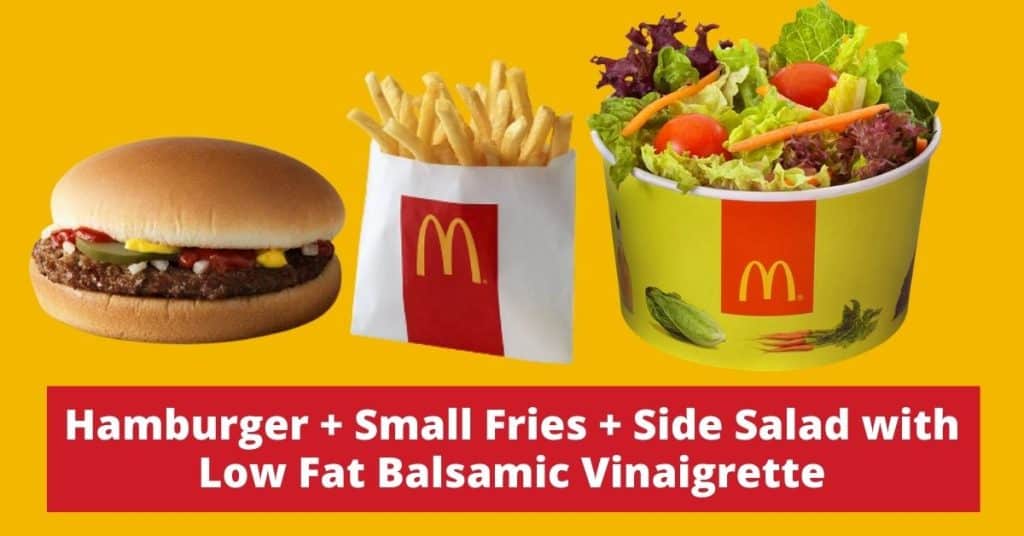
I wanted to show that it is possible to include a burger and small fries in an overall balanced meal plan. In addition, a side salad adds balance to the meal with vegetables for vitamins and fiber, and a minimal number of calories.
The total meal is 540 calories, with 78g of carbs, 16g of protein, and 23g of fat. The sodium content is high at 1420mg; this can be reduced to less than half by omitting the salad dressing.
While this meal is fairly high in carbohydrates and lower in protein, it is still healthy in the context of an overall day. Notice that a burger and fries and a salad all added up to the same as one Big Mac (540 calories).
Related Article: Eating at McDonald’s When Bulking or Cutting (6 Meals)
Healthy Meal Options from Subway
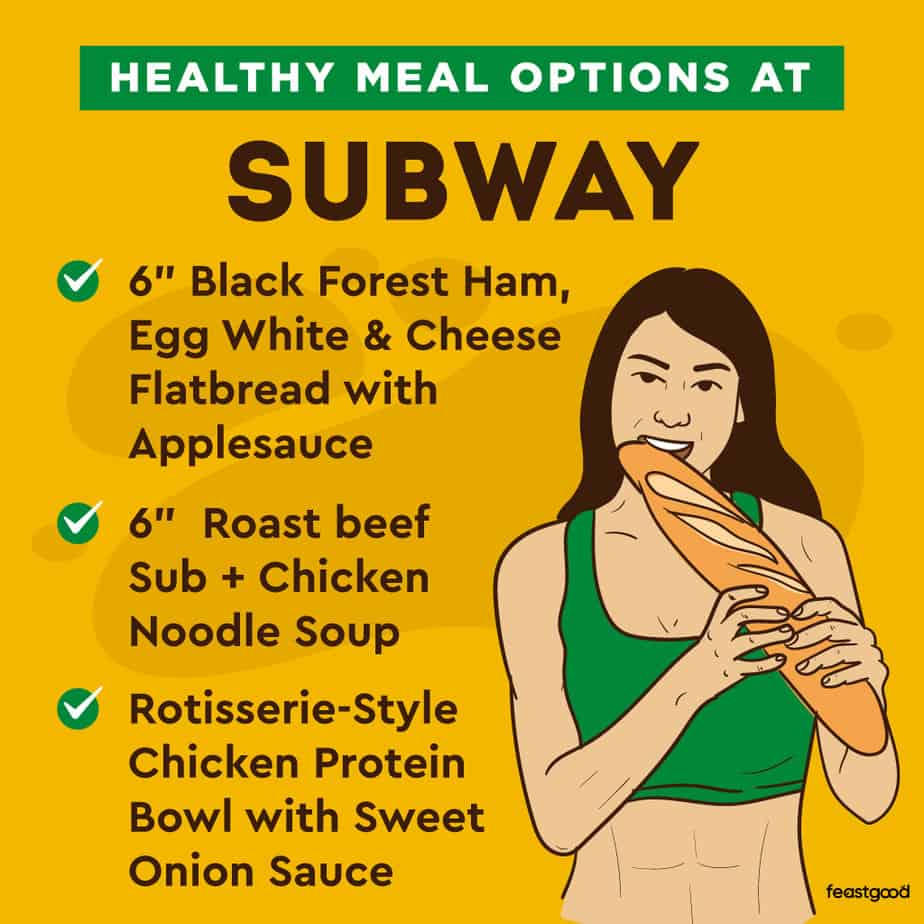
1. 6” Black Forest Ham, Egg White & Cheese Flatbread with Applesauce
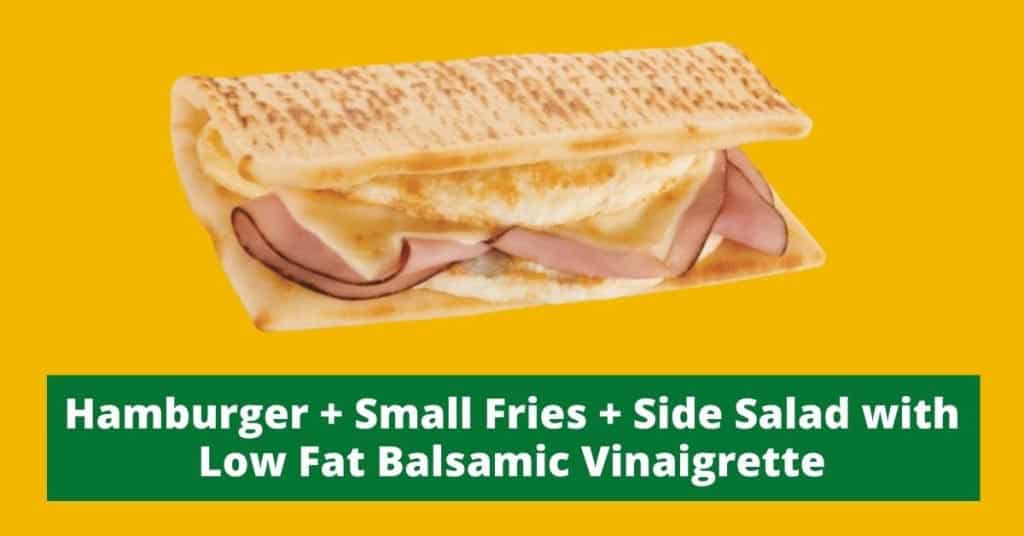
This breakfast flatbread is a balanced meal choice with 390 calories, 45g of carbs, 23g of protein, 12g of fat, and 1110mg of sodium.
Subway doesn’t have any fresh fruit options, so adding a container of applesauce is the only way to add fruit to this meal to get some additional vitamins. One serving has 45 calories, with 12g of carbs (no protein, fat or sodium).
If you are watching your sodium intake, removing the cheese can help reduce the sodium content by 210mg and also takes away 4g of fat and 2g of protein.
2. 6” Roast beef Sub + Chicken Noodle Soup
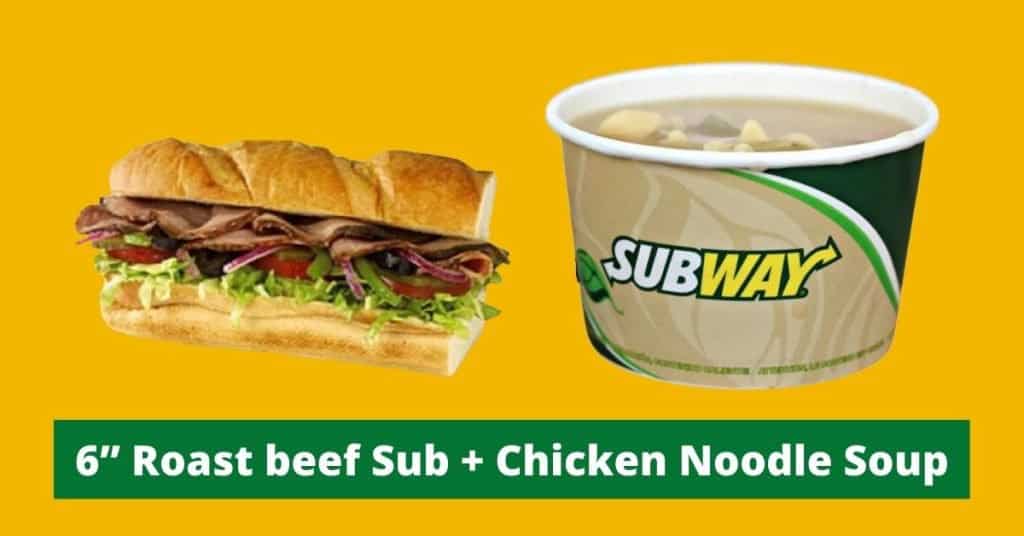
The combination of soup and a sandwich is a familiar and comforting meal, and at Subway this provides 400 calories, with 53g of carbs, 28g of protein, 8g of fat, and 1520mg of sodium.
This meal is quite high in sodium. This can be reduced by removing the soup (780mg), which also decreases the meal by 100 calories.
3. Rotisserie-Style Chicken Protein Bowl with Sweet Onion Sauce
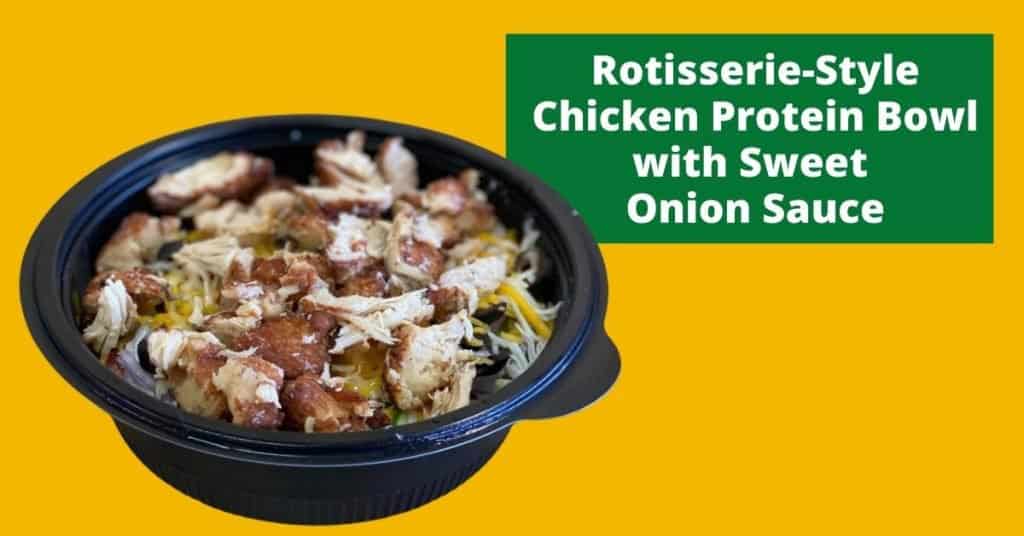
Turning any footlong sub into a Protein Bowl is a great way to get a high-protein meal that is lower in carbohydrates.
The Rotisserie-Style Chicken Protein Bowl is 220 calories, 12g of carbs, 31g of protein, and 8g of fat with 810mg of sodium
Adding Sweet Onion sauce adds 30 calories, which is one of the lowest-sodium dressing options after plain oil and vinegar.
Final Thoughts
Overall, Subway is a healthier fast food option than McDonald’s due to the lower calorie, carb, fat and sodium content, and the ability to customize your meal.
Other McDonald’s Comparisons
- Which Is Healthier Chick-Fil-A or Mcdonald’s?
- Which is Healthier: McDonald’s or Burger King?
- Which is Healthier: McDonald’s or KFC?
Other Restaurant Comparisons:
- Which Is Healthier Subway or Taco Bell?
- Which Is Healthier Chick-fil-A or Panda Express?
- Which Is Healthier Subway or Chipotle?
About The Author

Lauren Graham is a Precision Nutrition Level 1 certified nutrition coach. She focuses on helping busy professionals balance healthy eating and purposeful movement. Lauren has a background in competitive swimming and is currently competing as a CrossFit athlete. She has a passion for training, teaching, and writing.
Why Trust Our Content

On Staff at FeastGood.com, we have Registered Dietitians, coaches with PhDs in Human Nutrition, and internationally ranked athletes who contribute to our editorial process. This includes research, writing, editing, fact-checking, and product testing/reviews. At a bare minimum, all authors must be certified nutrition coaches by either the National Academy of Sports Medicine, International Sport Sciences Association, or Precision Nutrition. Learn more about our team here.
Have a Question?
If you have any questions or feedback about what you’ve read, you can reach out to us at [email protected]. We respond to every email within 1 business day.
